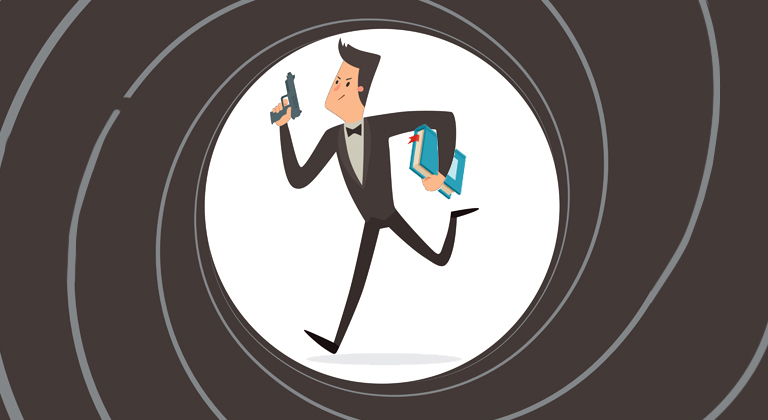How to Mine Your Email Mailing List
There’s a good reason why most authors start working on an email mailing list as soon as they can. Having a list of readers that love your work is not only a great ego boost, but can be an invaluable marketing tool. There are a variety of different ways to build your list, but the different techniques lead to different sorts of readers, each of whom provides a different value, assuming you know how to tell the difference and how to use each type.
That’s exactly what Ginger will be going over in this week’s blog. Not only how to identify and separate your subscribers into the types of benefits they can provide, but how best to attain those benefits without alienating anyone on your list.
Last month we posted a blog called Is Your Freebie Lead Magnet Costing You Money? The post addressed my belief that the source of your email mailing list subscribers has a huge impact on how effective they are at selling copies of your books. Long story short – if you generate your list by giving away free stuff, you might find it full of readers who only want free books.
The post generated a couple of really great questions, each of which deserve a blog post of their own. The first question we’re going to address comes from D. E. Heil, who is the author of a great thriller series called True Justice.
He asks:
Do you have any data suggesting that setting a reader magnet at 0.99 and advertising to it with an offer for a freebie inside that book does better in gathering readers who are willing to pay for a book for your email list?
This is a great tactical question that deserves a broader strategic answer – but I’d argue that the short answer is “yes” (I’ll give a longer answer in #5 of this list.) Any subscriber that joins your list after having spent money on your books will be inherently more valuable than one who signs up because of a freebie promotion.
That’s not to say subscribers who join your list from a free book giveaway can’t also be valuable. In fact, every reader on your subscriber list is more than valuable. They’re invaluable. They’re people who’ve become invested enough in your books to give you their private email address. It’s actually an incredible privilege, and not one you should ever take for granted.
So, in this blog post I’m going to talk about all the different ways in which your subscribers are valuable to you – and some of the tactics you can use to get more of each particular type of reader.
#1 A Subscriber is a Vote of Confidence
Books are one of the few commodities that cost you twice. You’ve not only got to buy a book, but you’ve also got to invest the time and attention to read it. The number of people who do both is often smaller than you might think – as observed in a quote most often attributed to Dorothy Parker: “Buying books and reading books are two entirely different hobbies.”
This is why getting anybody to subscribe to your mailing list is something to be proud of. It’s nothing short of a vote of confidence in your work and your brand – because unless you’re directly advertising to get subscribers (we’ll touch on this later) it’s very unlikely that anybody volunteered their email address without first reading and liking something you’ve written.
So, just from an overall perspective, always keep that in mind when you send anything out to your subscribers. These are your people and you can leverage them appropriately. Ask for feedback on covers and blurbs you’re considering. Query them about tropes and conventions that they might or might not like in your chosen genre. Use the opportunity to build a community of fans and engage with them without feeling a constant pressure to make them buy your books – because if you do it right, that’s what’s going to happen anyway. There’s a lot of value you can get from all your subscribers even if they don’t spend their money on your books.
Use the opportunity of your email mailing list to build connections with readers and that will put your books front-of-mind whenever they’re browsing for something to read, or making recommendations to other readers. Each person on your subscriber list is an ambassador for your work – so treat them appropriately.
#2 Track Where Your Subscribers Come From
That being said, the value of your subscribers does increase depending on where they came from, and you’re doing yourself a disservice if you don’t keep track of that.
Subscribers generally fall into two categories – organic and paid. Organic subscribers to your mailing list are those who joined ‘organically’ – as in, the only thing you had to do to convince them to click on your signup link was write something they really enjoyed. Paid subscribers are readers who joined your mailing list because you paid money to solicit them – either through direct advertising, as many of us do on Facebook, or through signing up via a book you gave away for free.
It can be really useful to track the source of each of your subscribers so you can differentiate between the two, and most email subscriber platforms (like Mailchimp or Mailerlite) provide the means to do so. For example, new subscribers to my list get flagged depending on whether they click on my signup link (which is included in every book I publish) or from a landing page (which is what I use when I pay to advertise for subscribers.) Depending on which service you use, you can possibly drill down even further with this – to the point of being able to determine which individual book a subscriber was reading when they decided to click to join your mailing list.
This can be hugely valuable because it gives you a lot of information about that subscriber – especially if you’re keeping track of what you’re doing with each book when they click to subscribe. A reader who joins your mailing list from a book that’s only available at full price ($4.99) is going to be more likely to spend similar amounts of money on your next book, whereas a subscriber who joined because of a free book you were offering through paid advertising might not be the sort of reader who pays for books very often.
This can be really useful when you’re trying to get value out of your subscribers, because it tells you a lot about their patterns of behavior. It’s great to build a Lookalike Audience on Facebook from a list of subscribers who’ve spent $4.99 on your books because you know they’re more likely to build an audience that is also willing to spend money.
#3 Separate your Subscribers
Once you’ve set up a system to tell you which subscribers came from where, it’s time to start using that information.
As I mentioned above, if you can keep track of readers who joined your mailing list organically, from a full-price book, then you should guard those email addresses jealously as they can be incredibly valuable.
If you’ve got more than 100 email addresses, you can use them to create a Lookalike Audience on Facebook (which I’ll describe in detail next week.) By supplying Facebook with a list of 100 users who spend money on your books, it will empower their algorithm to find users with a similar behavior profile and build your Lookalike audience from them. This can be an invaluable advantage when it comes time to making sure you only spend ad dollars on readers most likely to actually spend money buying your newest book, rather than on readers that look more like the people that signed up because they were offered something for free.
Likewise, when you release a new book, it’s often worth promoting it at full price to these subscribers first, since they’re more likely to buy it. These subscribers can really help a new book launch, as they have already proven willing to back you up with the only thing Amazon takes seriously – their dollars.
But that’s not to suggest your other subscribers are without value – far from it!
When I use Amazon’s Free Book Promotion to promote a book, it’s the paid subscribers I’ll promote that book to in an email blast – the ones who are used to getting books for free. Generally they’ll guarantee a lot of downloads on my book, which help it climb the free rankings, but at the same time it means I’m not cannibalizing my book sales by giving things away to an audience that would have been happy to pay for it.
That being said, it’s worth treating each audience with due respect. I’ll generally never give a book away for free unless I’ve already alerted my organic subscribers to it, and had it available for sale for a significant period of time. I want to reward subscribers who buy my books with the opportunity to get them much earlier than those who want a copy for free – so I’ll generally only run a Free Book Promotion some months after my official book launch.
Separating your mailing list like this can make your promotions much more effective, and allow you to make an impact over the course of several promotions rather than just one.
#4 Find Value from Other Means
That being said, subscribers who joined your list because they like getting free books can also offer incredible value to you in different ways. The most obvious of these is providing ARC reviews.
ARC, or Advanced Reading Copy, reviews are when you provide a digital copy of your book to a reader prior to publication. When your book does hit the digital bookshelves, you can reach out to these subscribers and ask them to leave a review on Amazon. It’s a great way to get early reviews for your book, and because they don’t have to pay for these books, subscribers are often very happy to do so as a show of support.
This is such a useful technique that it often justifies generating a list through giving away free books, since you’ll get that investment returned through the book sales that these reviews (hopefully) lead to. Experienced authors have often created a small, elite band of subscribers as their “ARC Team” who can deliver a reliable 30+ reviews (or more) each time they launch a book.
Similarly, readers who don’t pay for books are often useful as beta readers, or to provide feedback and advice on your works-in-progress. Remember, just because they joined your list because of a free book, it doesn’t erase that they joined your list because of your book. They’re into what you write. Reward them accordingly!
You can also leverage subscribers who don’t pay for books by encouraging them to share your posts on social media, and reach out to new readers in other ways. In fact, their action can often provide more value than a single book sale ever would!
Just remember to keep your core list of paying subscribers front and center. You don’t want them to feel that other readers are getting things for free when you’re taking it for granted that they’ll pay money for the same thing. Making sure the people who spend money feel like they’re getting the VIP treatment is the best way to ensure they keep buying your books!
#5 Determine Which Audience you Want to Build
Looping this back to D.E. Heil’s original question, being aware of what value a subscriber brings is something to keep forefront of mind when you put together a strategy for building your email mailing list.
If you build a list of subscribers through giving away free books, you’re going to end up with a list of readers who generally don’t like to spend money.
That’s fine – as I explained above, and it doesn’t mean those subscribers don’t have value. It’s just that there’s more direct value to be found in identifying and appealing to readers who do spend money.
Which is why a tactical approach like the one D.E. Heil suggested is worth considering. His idea was to have a book for sale at $0.99c, and have your mailing list signup included in that particular book, with a free book to sweeten the deal when they subscribe.
In many ways, this offers the best of both worlds. You know the readers are willing to spend money since they had to shell out $0.99 for the book – so they’re going to be more likely to do so again, even though you’ve provided them with an additional book for free.
It’s actually a similar approach to one I’ve used when I’ve been separating out my existing mailing list. I have about 3,000 readers on my current mailing list – some who joined organically, and others who joined because I was giving away free books. I was able to split this list into “people who pay” and “people who don’t pay” by launching one of my new books at 99c and promoting it to my entire list via an email blast.
The readers who clicked on the link that directed them to the 99c book identified themselves as people who pay money to read. Maybe not the full sticker price of my books (which is normally $4.99) but enough to demonstrate that they put their money where their mouth is. When I started off trying to build a Lookalike Audience on Facebook, this is how I generated enough email addresses to do so.
A similar approach externally could provide the same service. A book at 99c is easier to promote and more likely to generate paid sales, but those sales are paid – and any subscribers you gain as a result will have proven that they’re willing to pay money for the privilege.
So, I’d definitely consider that as an option – with one caveat:
Just as I outlined how there’s a separation between people who pay money for books and people who don’t, there’s also a separation between readers who pay full price for books and those who like to snap up bargains. Just like readers who download free books generally only download free books, readers who pay 99c for a book are normally spoiled for choice at that price-point, so are noticeably reticent about paying any more. I call it the Bookbub factor, since it’s a phenomenon often experienced by authors advertising on Bookbub, where readers are generally looking for a ‘deal’ rather than a full-priced book.
At the end of the day, you generally get exactly the type of readers you try to reach out to – which means if you give away tons of free books, you’ll get freebie hunters. If you promote books at 99c, you’ll get bargain hunters. It’s only when you promote full-priced books that you’ll find people joining your subscriber list who are willing to pay that much.
The most sustainable way of growing an email mailing list that spends money is to take it slow and steady and promote your books at full price. You’ll get fewer subscribers that way – a lot fewer – but over the course of several months or years, those subscribers are the ones who can help elevate your writing into a full time career.












this was a very helpful article. I’m just at the beginning of all this–no emails or newsletters yet. I had an assistant (who is also a writer)
help me publish my women’s fiction novel recently, and she insisted the reader magnet freebie was key to attracting subscribers. So I wrote a short story with that purpose in mind, that ended up being a really good story. Like, so good I didn’t want to give it away, LOL.I want to release it on its own, and I might. I don’t know. At 57, I’m not technically proficient and I guess I still haven’t bought into all this NL stuff paying off. Thanks for your posts though. They are always encouraging and with good info!
This is great. Especially the 99c lookalike audience, what a great idea. I wonder if you could use bookbub ads similarly — get a 99c featured deal (like it’s so easy, heh) and retarget your own audience? Build folks more likely to buy your stuff?
Also I am a wide reader and I’ll note that Apple and B&N readers read through after free series starters at a pretty high rate. (At least on my space operas.) interesting. Thank you!!
Wide author that is 🙂